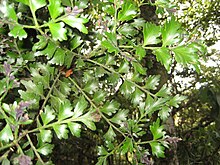Phyllocladus trichomanoides
| Tanekaha | |
|---|---|

| |
| Scientific classification | |
| Kingdom: | Plantae |
| Clade: | Tracheophytes |
| Clade: | Gymnospermae |
| Division: | Pinophyta |
| Class: | Pinopsida |
| Order: | Araucariales
|
| Family: | Podocarpaceae |
| Genus: | Phyllocladus |
| Species: | P. trichomanoides
|
| Binomial name | |
| Phyllocladus trichomanoides D.Don
| |
Phyllocladus trichomanoides, the tānekaha or celery pine, is a
.Description
Tānekaha is a medium-sized forest tree growing up to 25 m in height and 1 m trunk diameter.[2] The main structural shoots are green-skinned for 2–3 years, then turn brown as the bark thickens. The leaves are sparse, tiny, scale-like, 2–3 mm long, and only green (photosynthetic) for a short time, soon turning brown.
Most photosynthesis is performed by phylloclades, highly modified, leaf-like short shoots; these are arranged alternately, 10-15 on a shoot, the individual phylloclades rhombic, 1.5-2.5 cm long. The seed cones are berry-like, with a fleshy white aril surrounding but not fully enclosing the single seed.
Distribution
In the North Island this species is found in lowland forests from Te Paki to 40°S.[2] In the South Island this species is found in northern Marlborough and Nelson to 41°30'S.[2]
Pests and diseases
This species plays host to the New Zealand endemic beetle Agapanthida morosa.[3]
Economic uses
Like the
The bark is rich in tannin, from which Māori extracted a red dye.
References
- ^ "Phyllocladus trichomanoides D.Don". GBIF. Retrieved 14 November 2021.
- ^ ISBN 9780909010089.
- Wikidata Q56166058.

